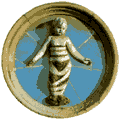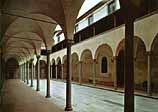
Andrea della Robbia,
Glazed terracotta
Ospedale degli Innocenti was the first institution of its kind in Europe
(1419). It was created to take care of and bring up orphans and abandoned
children as well as give them a trade. The Hospital was built during
the Repubblica Fiorentina , financed by the Arte della Lana, by Filippo Brunelleschi, who carried out a harmonic and rational
example of hospital architecture which also included cloisters, porticos, refectories,
dormitories, infirmaries and nurseries. When it was restored after the flood
in 1966 an attempt was made to show more of the 15th century structures.
On the left of the portico one can see an inscription
above a small closed window, decorated by two puttos. It is there as a reminder
of the "wheel", which functioned until 1875, where mothers placed their
unwanted babies when they were unable to bring them up. Today the surname "Degli
Innocenti", in its various forms, can still be said to have originated from
here.

Brunelleschi,
the cloister
The loggia above the portico (once the children's sitting room) can
be reached from the pretty central courtyard below. Today it contains
a small museum of works of art gathered together over the centuries thanks
to bequests and donations, most of them unfortunately dispersed in the
19th century. It contains detached frescoes and works by Luca
della Robbia, Sandro
Botticelli, Piero di Cosimo and here one can admire the splendid Adoration of
the Shepherds by Domenico Ghirlandaio, the teacher of Michelangelo (1488), where the artist painted
- as was his habit - a series of historical portraits among the crowd surrounding
the Child: merchants from the Arte della Seta,
attendants and benefactors of the hospital.
Once outside the Innocenti, one should take Via dei Fibbiai where one can find
the Rotunda of Santa Maria degli Angeli (1433), the unfinished work of Brunelleschi, that was rediscovered and restored
during this century.

St. Maria Maddalena dei Pazzi
If you go from the Rotunda in via degli Alfani and then on the left
in Borgo Pinti, near number 58, you can see Church and Monastery of Santa
Maria Maddalena dei Pazzi.
The Monastery, builded in the XIII century for the Benedectines, was altered
in the later '400. Giuliano da Sangallo, the brother of Antonio,
made the beautiful entrance cloister (1492-1505), that remembers Chapel Pazzi
by Brunelleschi in Santa
Croce, and the project of the new inner space. Through the mysterious passages,
you reach the Capitular Hall and the great Crucifixion fresco by Perugino.
